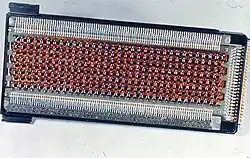Core rope memory
Core rope memory is a form of read-only memory (ROM) for computers, first used in the 1960s by early NASA Mars space probes and then in the Apollo Guidance Computer (AGC)[1] and programmed by the Massachusetts Institute of Technology (MIT) Instrumentation Lab and built by Raytheon.

| Computer memory and data storage types |
|---|
| Volatile |
| Non-volatile |
Software written by MIT programmers was woven into core rope memory by female workers in factories. Some programmers nicknamed the finished product LOL memory, for Little Old Lady memory.[2]
Memory density

By the standards of the time, a relatively large amount of data could be stored in a small installed volume of core rope memory: 72 kilobytes per cubic foot, or roughly 2.5 megabytes per cubic meter. This was about 18 times the amount of magnetic-core memory (within two cubic feet).
| Memory technology |
Data units per cubic foot | Data units per cubic meter | ||
|---|---|---|---|---|
| Bytes | Bits | Bytes | Bits | |
| Core rope ROM | 72 KB | 576 Kbit | ~2.5 MB | ~20 Mbit |
| Magnetic-core RAM | 4 KB | 32 Kbit | ~140 KB | ~1 Mbit |
References
- "Software as Hardware: Apollo's Rope Memory". Retrieved 29 Sep 2017.
- Directed and Produced by: Duncan Copp, Nick Davidson, Christopher Riley (2008-07-07). "The Navigation Computer". Moon Machines. Episode 3. 22:40 minutes in. Science Channel.
External links
- "Computer for Apollo" NASA/MIT film from 1965 which demonstrates how rope memory was manufactured.
- Visual Introduction to the Apollo Guidance Computer, part 3: Manufacturing the Apollo Guidance Computer. – By Raytheon; hosted by the Library of the California Institute of Technology's History of Recent Science & Technology site (originally hosted by the Dibner Institute)
- Computers in Spaceflight: The NASA Experience – By James Tomayko (Chapter 2, Part 5, "The Apollo guidance computer: Hardware")
- Brent Hilpert's Core Rope & Woven-Wire Memory Systems page has a detailed explanation of pulse-transformer and switching-core techniques.
- SV3ORA's Core rope memory: A practical guide of how to build your own gives a description, schematics and photos of a simple core rope memory board using the pulse transformer technique, including a demonstration of operation.
- Software woven into wire: Core rope and the Apollo Guidance Computer, extensive blog post by computer restoration expert Ken Shirriff
- Australian 'ropes' demonstrated at MIT Letter from Ramon L. Alonso to Gordon Rose, dated 10 December 1963: "We are finding the Australian ideas on ‘ropes' to be very fruitful indeed, and we are going ahead with some development work on them."